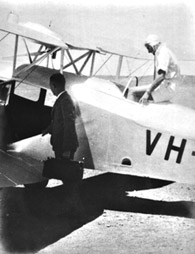
Royal Flying Doctor Service
1928
medical services using radio and aircraft
Deep in the outback, isolation, distance and poor communications can make medical emergencies especially dangerous. The Reverend John Flynn, a roving outback missionary of the Presbyterian church's Australian Inland Mission realised that aeroplanes and radio could save lives in the outback. As a result of his vision and stubbornness, the Aerial Medical Service began in 1928 at Cloncurry in outback Queensland.
In 1926 he recruited Alf Tragear, an electrical engineer, to solve the problem of communicating with isolated farms and communities. Traeger realised that it was impractical to transport batteries over rough bush tracks. He designed a radio powered by a set of bicycle pedals that could generate just enough power to send a message in Morse code. With this simple radio, outback people could call for a doctor, and doctors could send instructions and communicate with base up to 1500 km away.
At first the 'Flying Doctor' as it became known was basically an emergency air ambulance, with one aircraft, one pilot and one doctor. Patients 'called' them in morse code using their two-way pedal powered radio.
By 1931 the Royal Flying Doctor Service (RFDS) had gone national, the pioneer of many similar services around the world, and eventually radio communication was by voice rather than code.
It was fine to have a doctor in the air, but what could you do till they came? In 1951 Sister Lucy Garlick drew up a numbered chart of the human body to go with a kit of numbered medicines and equipment. The doctor could now diagnose the problem over the radio and prescribe treatment.
Imagine ...
'Doc, I've got a rash on my number 11. Over.'
'Well just rub on some 46 until I get there. Over and out.'
Now the RFDS covers an area over 7 million sq kms and in 1997-98 attended an average of 498 patients per day.
Who Did It?
Key Organisations
Royal Flying Doctor Service of Australia : operator
Key People
John Flynn : founder and developer
Clifford Peel : conceived idea
Alfred Traeger : developed pedal radio
Harry Kauper : designer of pedal radio
Further Reading
Australian genius: 50 great ideas
Vivien Encel
Atrand, Crows Nest NSW, 1988, pp 49-52.
Links
Royal Flying Doctor Service
of Australia
RFDS Central Section.
Includes videos
Flinders
Ranges Research
Mobil Outback Air Race
Biography
of Flynn
Behind
the News - Australians
Alf
Treager Memorial
Pedal
Radio of the Great Outback
Related Innovations
School of the Air
|











